If you’ve ever wandered through a meadow or glanced at a thriving backyard lawn, chances are you’ve seen clover quietly doing its job—greening the soil, feeding the bees, and fixing nitrogen without much fuss. But did you know there are dozens of different types of clover plants, each with its own look, bloom color, and practical use? From sturdy pasture varieties to low-growing lawn companions, clovers are far more diverse than most people realize.
In this article, we’ll explore 40 of the most common and useful types of clover plants, complete with names and pictures to help you recognize them in your garden or out in the wild. Whether you’re planting a cover crop, building a pollinator patch, or just curious about what’s growing between your stepping stones, there’s a clover variety here worth knowing.
As a gardener, learning about the different types of clover plants can open the door to more sustainable, low-maintenance growing. These plants aren’t just pretty—they’re practical workhorses that enrich the soil, attract beneficial insects, and thrive in tough conditions. Let’s dig in and get to know them better.
Different Types of Clover Plants
White Clover (Trifolium repens)
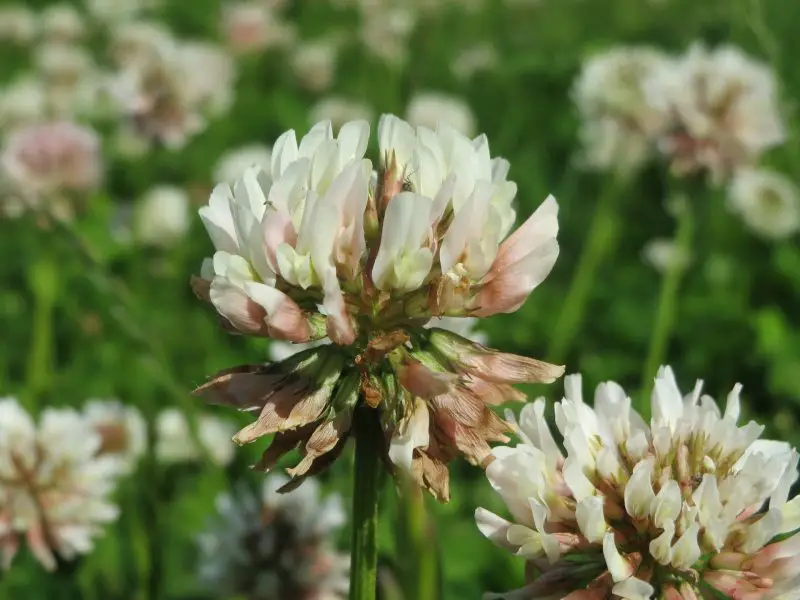
White clover is a low-growing perennial plant known for its trifoliate leaves and white, ball-shaped flowers. Its creeping stems root at the nodes, allowing it to spread effectively across lawns, pastures, and open fields. This species is extremely resilient and can tolerate moderate foot traffic, grazing, and mowing.
Native to Europe and Central Asia, white clover has become naturalized in temperate regions around the world, particularly in North America and New Zealand. It thrives in moist, well-drained soils and prefers full sun to partial shade. Its blooming season typically spans from late spring through early fall, depending on the climate.
White clover plays a critical role in agriculture as a nitrogen-fixing legume. It enriches soil fertility without the need for synthetic fertilizers and is often planted as a cover crop or ground cover in orchards, gardens, and pastures. Additionally, it serves as a nutritious forage plant for livestock and supports pollinators like bees.
Red Clover (Trifolium pratense)
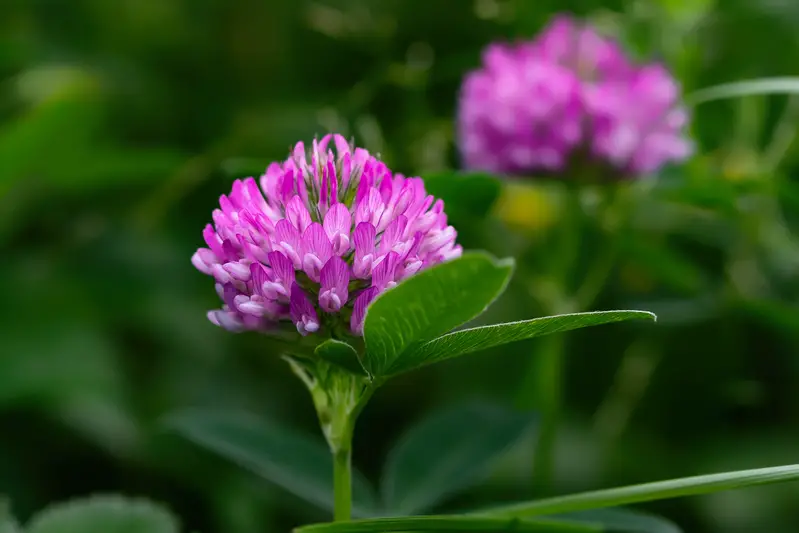
Red clover is a short-lived perennial or biennial legume with upright, hairy stems and distinctive rosy-purple flower heads. Its blooms are larger than those of white clover and form a rounded cluster at the top of the stem. The plant’s foliage features characteristic pale markings shaped like chevrons on each leaflet.
This species is native to Europe, Western Asia, and Northwest Africa, but it is now cultivated widely in North America and temperate regions worldwide. Red clover prefers fertile, slightly acidic to neutral soils with good drainage and full sun exposure. It typically flowers from late spring to mid-summer.
Red clover is valued as a high-quality forage crop, especially for hay and silage, and is commonly used in crop rotations to enhance soil nitrogen levels. It is also used in herbal medicine for its phytoestrogen content, believed to support hormonal balance. Its flowers attract a wide range of pollinators, contributing to biodiversity.
Crimson Clover (Trifolium incarnatum)
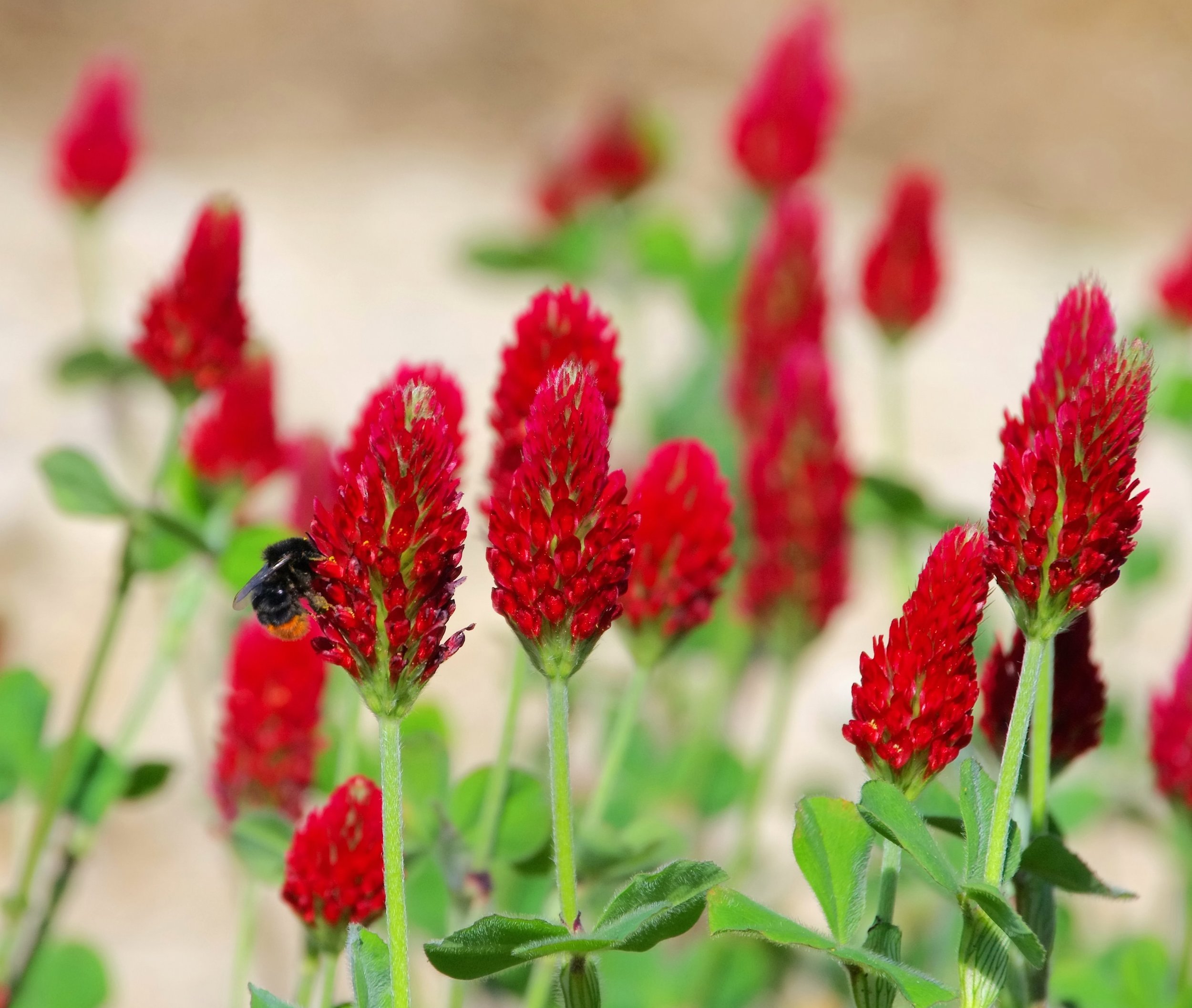
Crimson clover is an annual clover species admired for its vibrant crimson-red flower spikes that stand upright above dark green foliage. The plant grows to a height of about 12 to 20 inches and has hairy stems and leaves. It is particularly striking when planted in mass, forming a sea of red in spring.
Originally from southern Europe, crimson clover is now commonly used across the southeastern United States and other mild-climate regions. It thrives in well-drained soils and full sun, and it grows rapidly in cool seasons. Flowering usually occurs in mid to late spring and lasts several weeks before the plant sets seed.
Crimson clover is highly valued as a winter cover crop due to its nitrogen-fixing abilities and erosion control. After blooming, it can be tilled into the soil as green manure, improving organic matter content. While not as commonly grazed as white or red clover, it can provide limited forage and is widely appreciated by pollinators.
Alsike Clover (Trifolium hybridum)
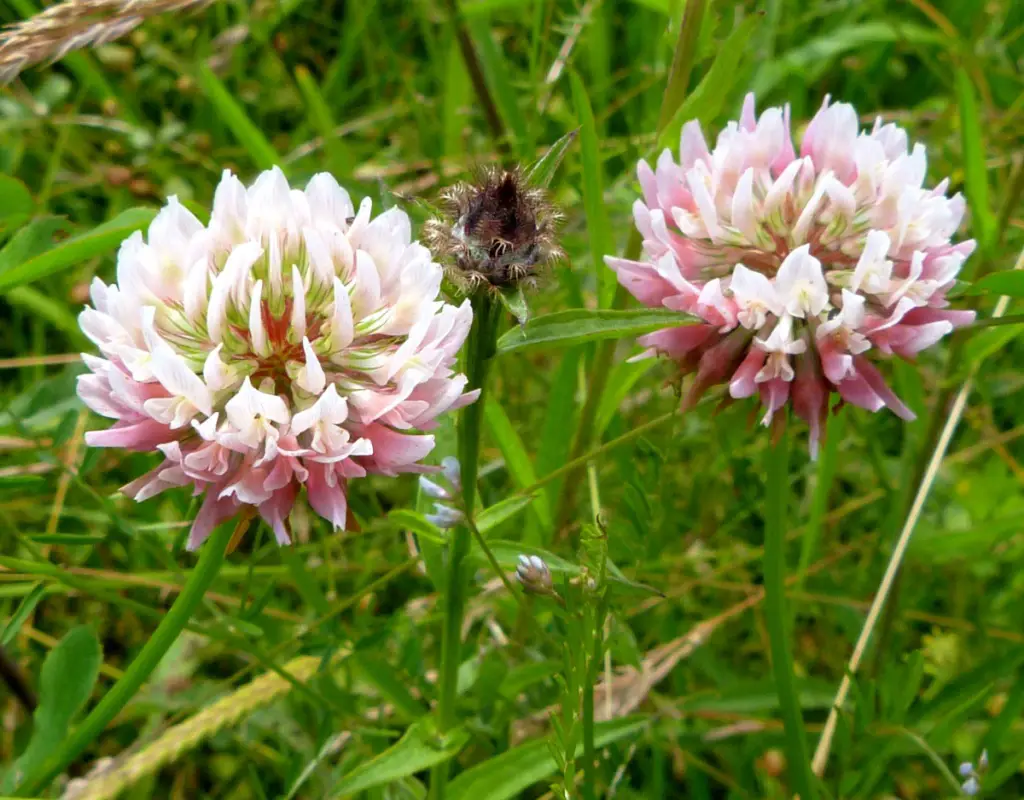
Alsike clover is a perennial species that produces small, pink to pinkish-white flower heads atop slender, smooth stems. Its foliage resembles that of white clover but without the characteristic chevron marks. The plant typically grows 1 to 2 feet tall and thrives in moist conditions.
Native to Europe and western Asia, Alsike clover is now naturalized in North America and used in regions with cool, wet climates. It is particularly tolerant of poor drainage and acidic soils, making it suitable for pastures and meadows where other clovers may struggle. Its bloom time generally runs from late spring to midsummer.
While Alsike clover is excellent for hay and pasture mixes, it should be used with caution around horses, as it may cause photosensitization when consumed in large quantities. Nevertheless, it provides nutritious forage for cattle and sheep and plays a role in improving soil fertility and supporting pollinator populations.
Arrowleaf Clover (Trifolium vesiculosum)
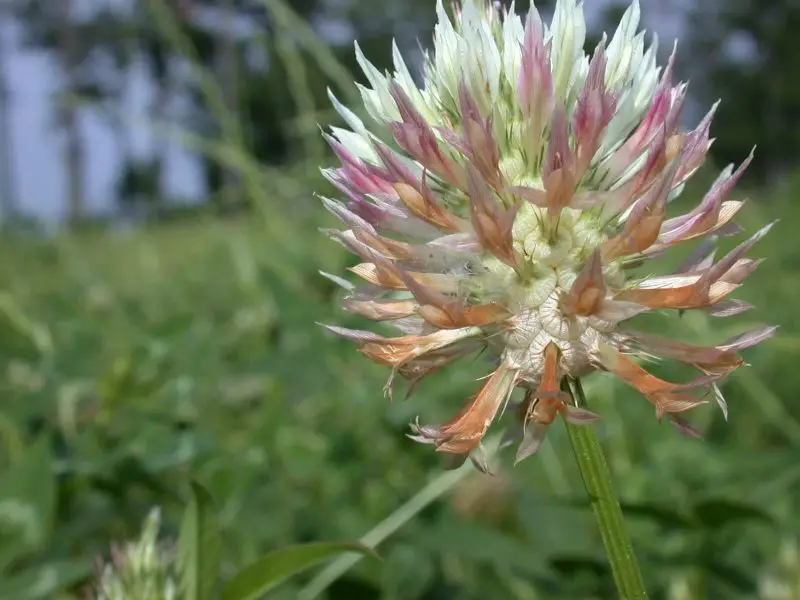
Arrowleaf clover is a cool-season annual legume characterized by its tall growth (up to 3 feet), arrowhead-shaped leaves, and white to pale pink flower clusters. Its upright growth habit and late flowering time distinguish it from other common clovers, allowing it to extend grazing seasons.
Native to the Mediterranean region, arrowleaf clover has become widely adapted in the southern United States, especially in areas with mild winters and well-drained soils. It does best in sandy or loamy soils and full sun, typically blooming in late spring, often after other clovers have completed their cycle.
Arrowleaf clover is highly valued in forage systems for cattle and deer. It produces high biomass, fixes significant amounts of nitrogen, and can be incorporated into pasture mixes or used as a winter cover crop. Its delayed blooming is advantageous in rotational grazing systems, offering feed after other legumes have matured.
Berseem Clover (Trifolium alexandrinum)
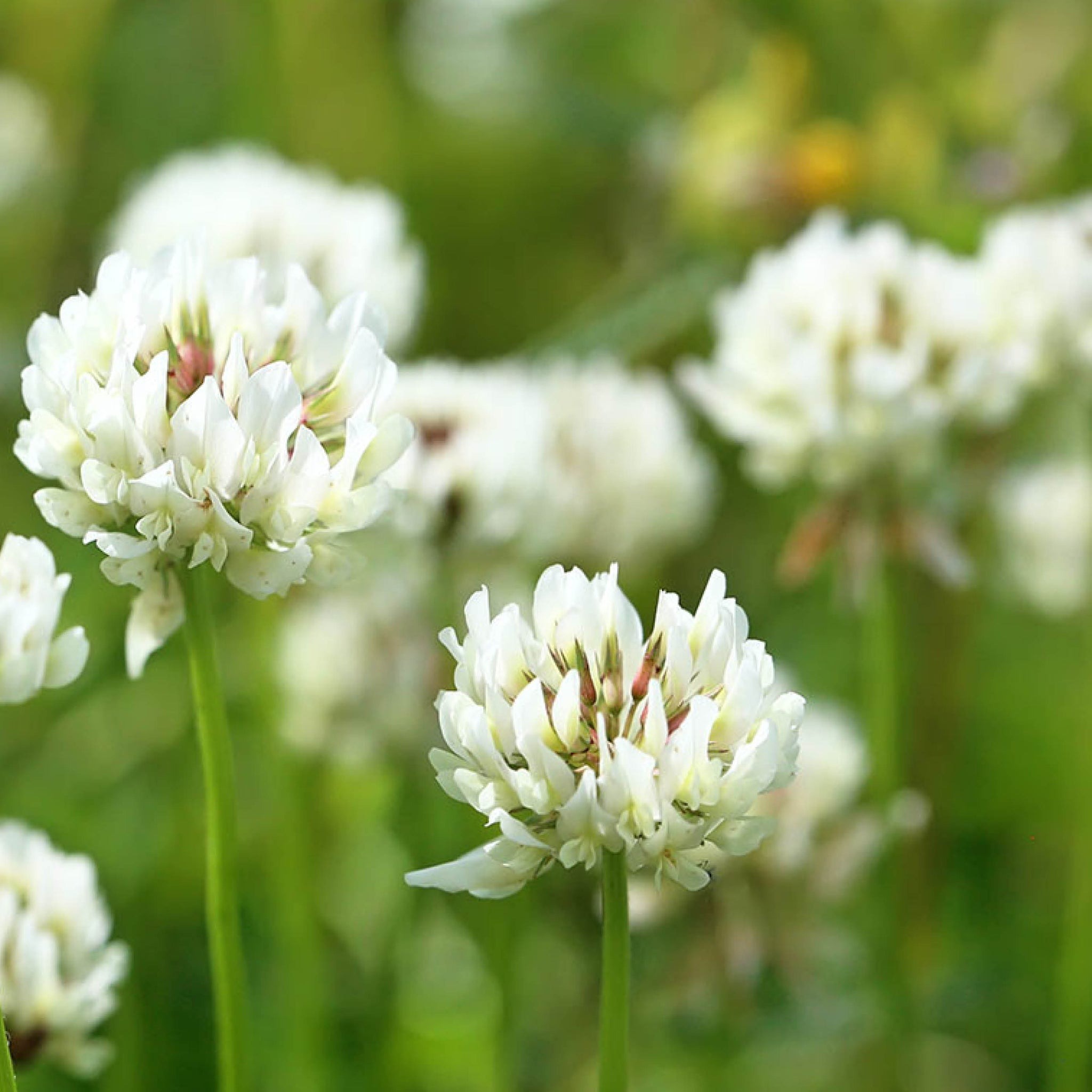
Berseem clover is a fast-growing annual legume with lush, erect stems and soft, light green foliage. Its flower heads are creamy white and resemble those of white clover, though slightly larger and more loosely arranged. The plant can grow up to 2 feet tall under optimal conditions and is well-suited to warm, fertile environments.
Native to the Nile River Valley in Egypt, berseem clover thrives in Mediterranean and subtropical climates. It prefers deep, well-drained loamy soils with good moisture retention and grows best in full sun. Flowering generally occurs from late winter through spring, depending on regional temperatures and rainfall patterns.
Berseem clover is widely cultivated as a forage crop and is especially popular in regions like India, Egypt, and parts of the southern United States. It is an excellent source of green fodder for livestock and is often used in rotation systems for its nitrogen-fixing benefits. Its rapid regrowth makes it a valuable crop for multiple harvests per season.
Subterranean Clover (Trifolium subterraneum)
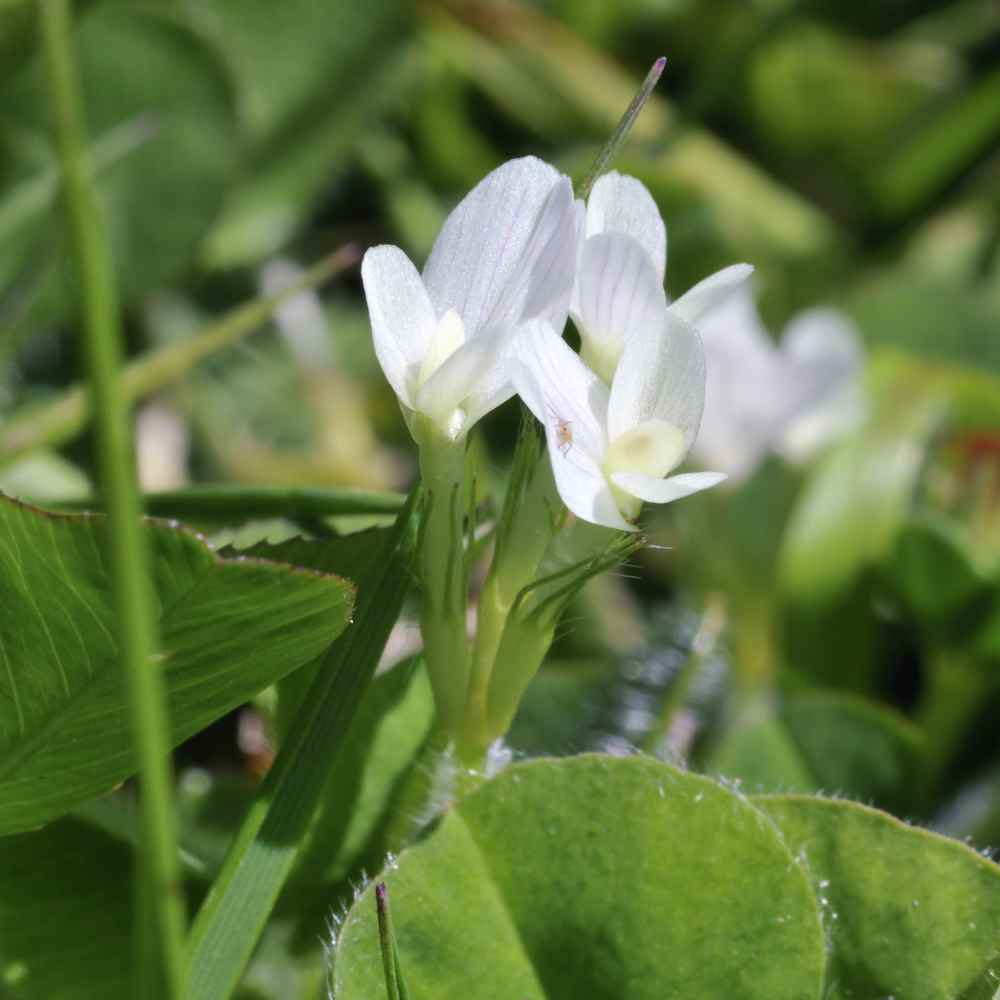
Subterranean clover is a low-growing annual legume with soft, hairy leaves and small white to pale pink flowers. A unique feature of this species is its ability to produce seeds underground, which allows it to reseed itself naturally year after year. The plant forms dense mats that help suppress weeds and prevent erosion.
Native to the Mediterranean Basin, subterranean clover has been extensively adopted in Australia and other temperate regions with mild winters and hot, dry summers. It thrives in acidic to neutral soils with good drainage and performs well in pastures and open fields. Flowering usually occurs in mid to late spring.
This clover is especially useful for sustainable grazing systems, as it provides high-quality forage for sheep and cattle during the cool season. Its capacity to self-reseed and maintain ground cover with minimal intervention makes it an ideal species for long-term pasture management. It also enhances soil fertility through nitrogen fixation.
Persian Clover (Trifolium resupinatum)

Persian clover is an upright annual legume known for its attractive lilac to pinkish-purple flowers and rounded, slightly toothed leaves. It has a soft, leafy growth habit and typically reaches heights between 1 to 2 feet. The flowers are fragrant and arranged in compact, rounded heads, which are highly attractive to bees.
This species is native to Western Asia and the Middle East but is now cultivated in regions with Mediterranean and temperate climates. Persian clover prefers fertile, well-drained soils and grows best in areas with cool, moist winters and warm springs. Blooming typically begins in spring and lasts through early summer.
Persian clover is often grown for forage and green manure. It is especially valuable in rotation systems for its quick biomass production and soil-improving qualities. Its lush, palatable foliage makes it ideal for livestock grazing, while its showy blooms add aesthetic appeal to managed landscapes and wildflower meadows.
Strawberry Clover (Trifolium fragiferum)
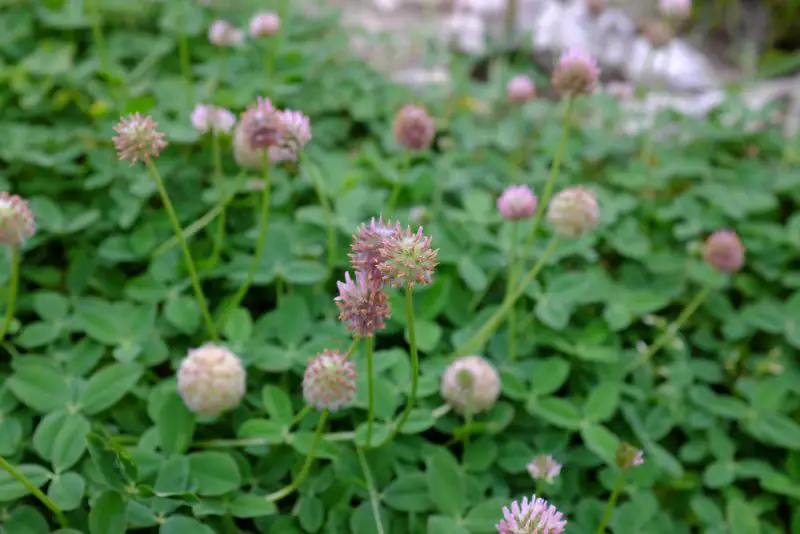
Strawberry clover is a low-growing perennial legume with round, fluffy pink flower heads and a spreading growth habit. The plant’s name comes from the appearance of its seed heads, which resemble small strawberries in shape and texture. Its leaves are glossy green and slightly toothed, forming dense mats across the soil surface.
Native to Europe and Western Asia, strawberry clover thrives in moist, saline, or alkaline soils, making it suitable for challenging sites like roadside verges, wet meadows, and coastal areas. It prefers full sun but can tolerate partial shade, and it typically blooms from late spring to mid-summer.
This clover species is often used for erosion control, ground cover, and reclamation of saline-affected soils. It also serves as a forage plant for livestock and provides nectar for pollinators. Strawberry clover is prized for its resilience, ability to fix nitrogen, and usefulness in pasture mixes for marginal land.
Rose Clover (Trifolium hirtum)
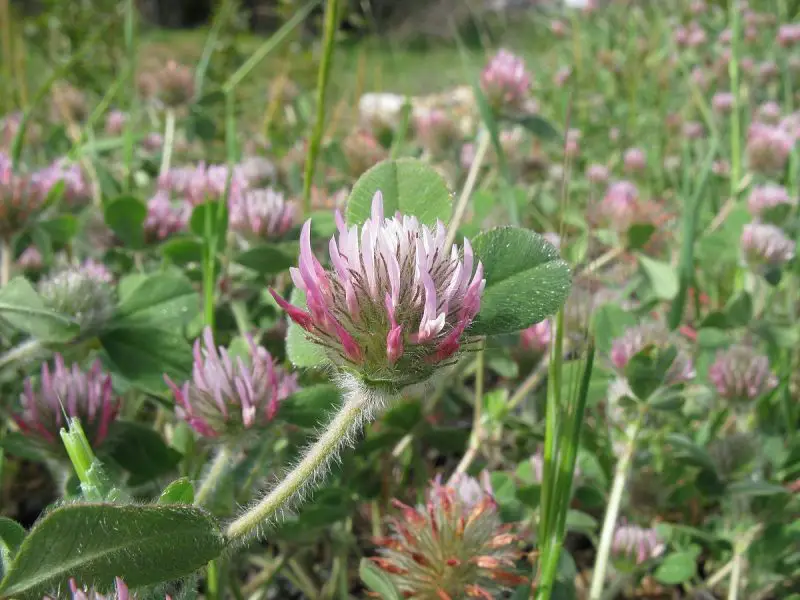
Rose clover is an annual legume with upright, hairy stems and vibrant rose to magenta-colored flowers. The flower heads are rounded and held above the foliage, making them easy to spot in naturalized fields and pastures. The plant has a compact growth habit and reaches heights of 1 to 2 feet.
Native to the Mediterranean region, rose clover adapts well to dry, well-drained soils and is especially drought-tolerant compared to many other clover species. It thrives in areas with mild, wet winters and dry summers, such as California and parts of southern Australia. It blooms from late spring through early summer.
Rose clover is used extensively in forage production, especially in arid and semi-arid environments. It contributes to soil fertility through nitrogen fixation and is appreciated for its aesthetic value in wildflower blends. Though it provides good forage, its primary value lies in improving soil health and covering bare or disturbed land.
Hop Clover (Trifolium campestre)
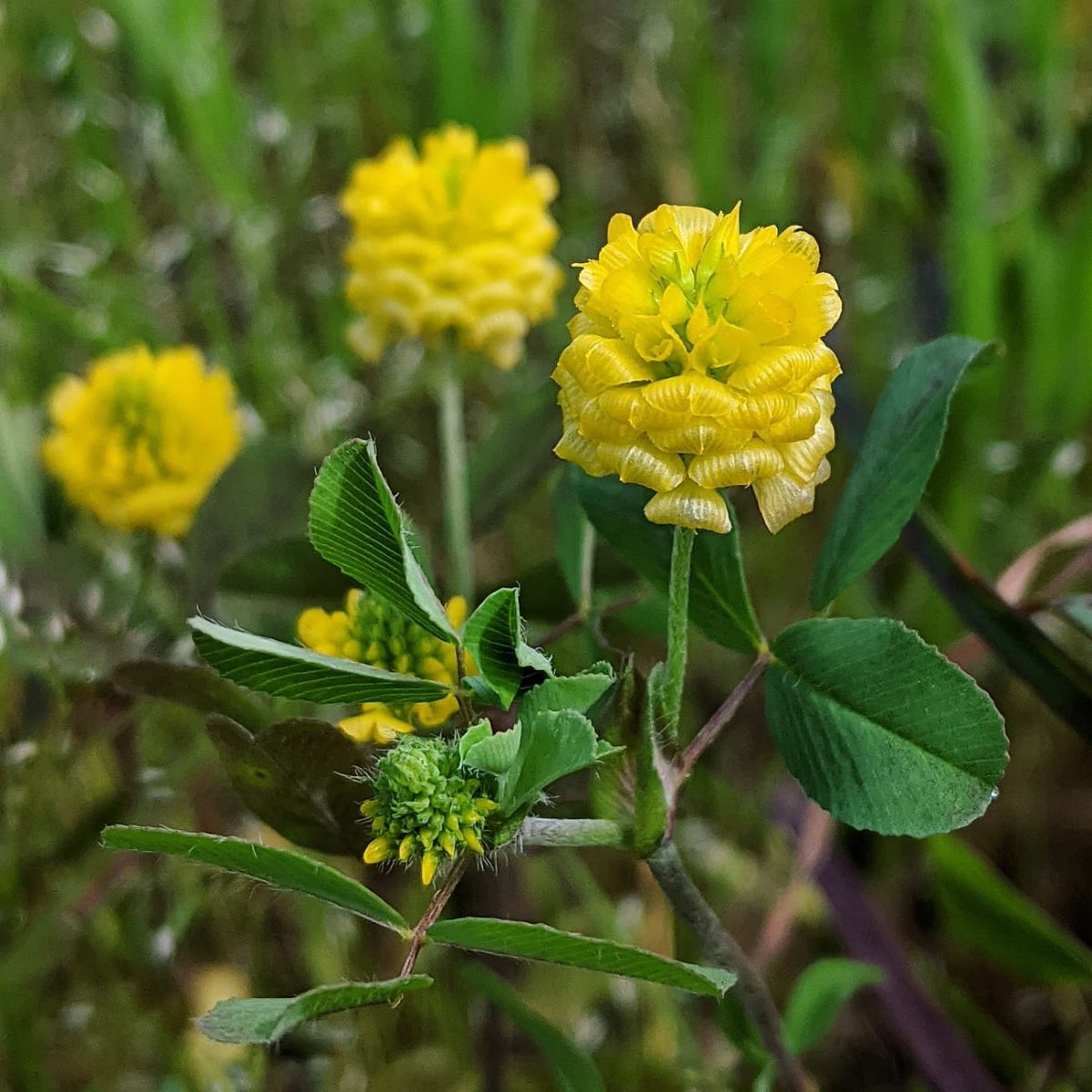
Hop clover is a small annual legume with yellow, hop-like flower heads that turn brown as they mature, giving the plant its common name. It grows up to 12 inches tall and has delicate, trifoliate leaves with rounded leaflets. The plant has a compact, slightly spreading form, making it ideal for ground cover in disturbed areas.
Native to Europe and western Asia, hop clover has naturalized across North America and is commonly found along roadsides, pastures, and dry grasslands. It prefers full sun and thrives in well-drained, moderately fertile soils. The plant typically blooms from late spring to early summer and is tolerant of drought and poor soil conditions.
Though often considered a weed in some regions, hop clover is useful for erosion control and soil improvement due to its nitrogen-fixing ability. It also provides nectar for pollinators and can be grazed by livestock, although its small size limits its value as a primary forage crop. Its adaptability to various environments makes it a hardy, low-maintenance species.
Rough Clover (Trifolium scabrum)
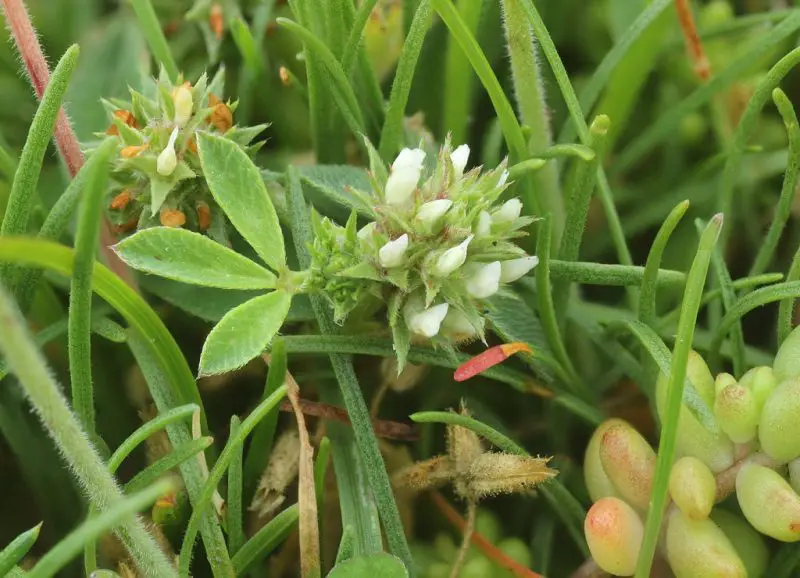
Rough clover is a low-growing annual species with small, white to pale pink flower heads and slightly hairy stems and leaves. The name “rough” refers to the texture of the plant’s foliage and seed pods, which have a coarse, scabrous surface. Its growth is typically prostrate, forming a mat across the ground.
This species is native to the Mediterranean and thrives in dry, nutrient-poor soils. It prefers full sunlight and is well-suited to regions with mild winters and hot, dry summers. Rough clover usually blooms in spring, often earlier than other annual clovers, and completes its life cycle quickly after flowering.
Rough clover is often included in low-maintenance pasture and erosion control seed mixes. Its resilience to drought and poor soils makes it valuable in revegetation and soil stabilization projects. Although it is not a high-yield forage crop, it supports biodiversity and contributes to soil health through nitrogen fixation.
Ball Clover (Trifolium nigrescens)
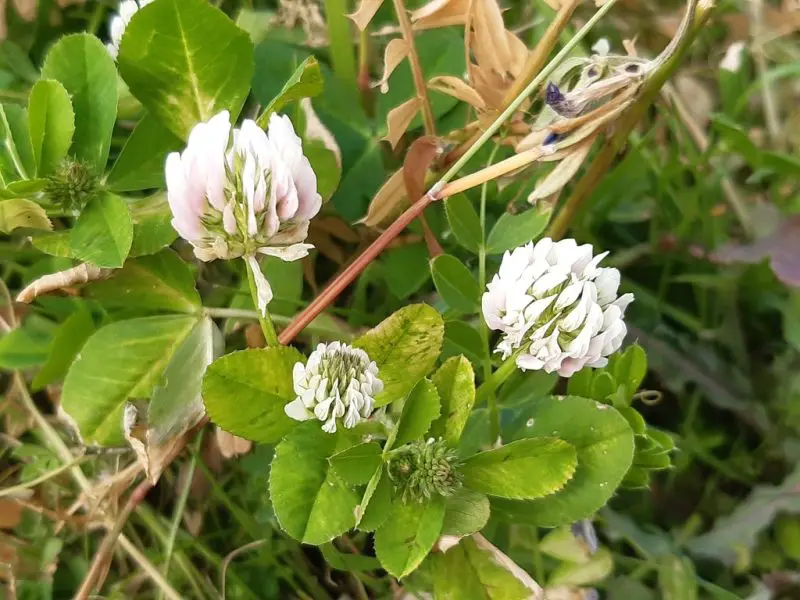
Ball clover is a winter annual legume named for its nearly spherical, white flower heads, which resemble small balls perched above the foliage. The plant has a semi-erect growth habit, reaching about 12 to 16 inches tall, with narrow, dark green leaflets. Its flowers are tightly clustered and mildly fragrant.
Native to Europe and parts of western Asia, ball clover has adapted well to the southeastern United States and similar climates. It grows best in moist, well-drained soils with full sun exposure and typically flowers from mid to late spring. The species is often found in fields, pastures, and along roadsides.
Ball clover is a popular forage crop, especially in the southern U.S., where it is valued for its early growth and excellent palatability. It provides high-protein forage for livestock and fixes nitrogen in the soil, benefiting subsequent crops. Additionally, its abundant blooms attract pollinators, making it a good companion in wildlife-friendly planting schemes.
Suckling Clover (Trifolium dubium)

Suckling clover is a very small, low-growing annual species with yellow flower heads and tiny, oval-shaped leaflets. It typically grows just a few inches tall and has a creeping habit, spreading quickly across lawns, meadows, and other grassy areas. The plant’s name refers to its fine, delicate form.
Native to Europe and western Asia, suckling clover has become widespread in North America and other temperate regions. It is highly adaptable and grows in a wide range of soils, including poor, compacted, or disturbed sites. It blooms in spring and early summer, and its yellow flowers often resemble those of hop clover.
Despite its small size, suckling clover is useful for erosion control and improving soil health, thanks to its nitrogen-fixing ability. It is sometimes used in lawn mixes and wildflower meadows for added ground coverage. While it has limited forage value due to its diminutive stature, it supports biodiversity and resists foot traffic well.
Large Hop Clover (Trifolium aureum)
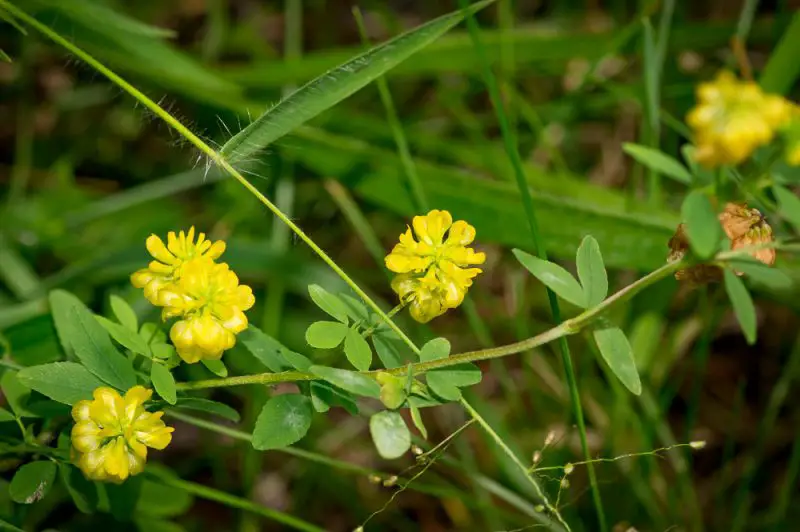
Large hop clover is a taller, more robust version of common hop clover, with bright yellow flower heads and broader leaves. Its blossoms are more elongated than rounded, often resembling the flower heads of hops used in brewing. The plant grows between 1 and 2 feet tall and has a more upright growth habit than its smaller relatives.
This species is native to Europe and has naturalized in parts of North America. It thrives in full sun and tolerates dry, poor soils, including gravelly or sandy sites. Large hop clover is often found in open fields, roadsides, and disturbed areas. Blooming occurs in late spring to early summer, depending on local climate conditions.
Although it is not widely used in agriculture, large hop clover plays a role in soil stabilization and habitat restoration. Its ability to tolerate adverse growing conditions makes it a candidate for erosion control. Like other legumes, it fixes nitrogen in the soil and supports pollinators, especially bees, with its bright, nectar-rich flowers.
Low Hop Clover (Trifolium campestre var. minus)
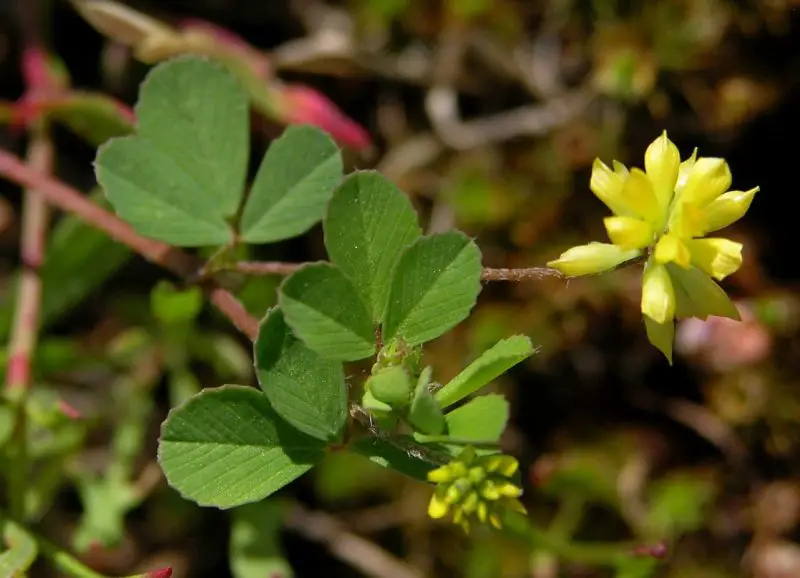
Low hop clover is a diminutive variety of the common hop clover, notable for its small stature and delicate yellow flowers. This variety typically grows only a few inches tall and forms a spreading mat of fine stems and trifoliate leaves. Its flower heads are compact and turn brown with age, maintaining the hop-like appearance.
It is commonly found in dry meadows, roadside verges, and open, grassy areas, especially in Europe. Low hop clover thrives in full sun and poor, well-drained soils, often preferring disturbed or low-fertility habitats. It is well-suited to Mediterranean and temperate climates, with a bloom period that spans late spring to early summer.
While not widely cultivated for agriculture, low hop clover plays a useful role in erosion control and natural ground cover. Its nitrogen-fixing properties help improve soil quality, and it supports pollinators with its nectar-rich blossoms. Due to its compact size and low growth, it’s often included in ecological restoration and low-maintenance landscapes.
Mountain Clover (Trifolium montanum)
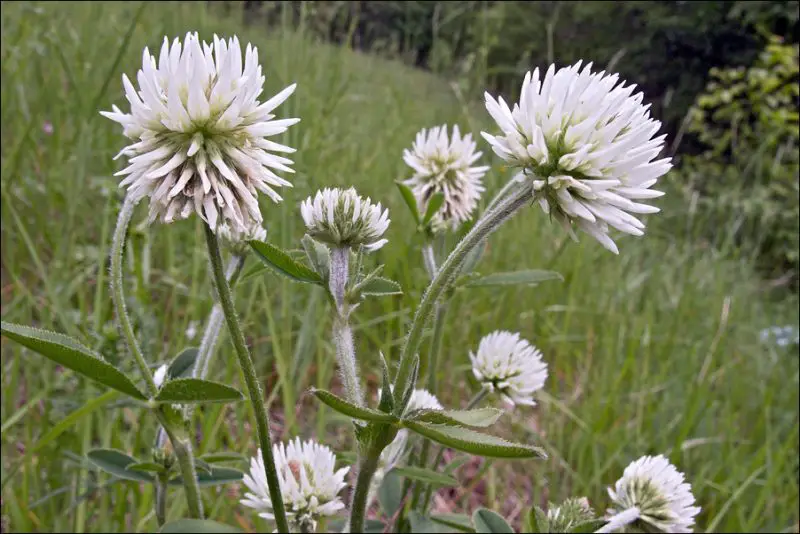
Mountain clover is a perennial clover species with creamy-white to pale yellow flower heads and upright stems that can grow up to 24 inches tall. Its leaves are trifoliate, with slightly toothed margins, and its growth form is more robust than many other wild clovers. The flowers are borne in dense, elongated clusters.
As the name suggests, mountain clover is native to high-altitude meadows and slopes in central and southern Europe. It prefers calcareous soils and thrives in full sun to partial shade in open forests and grassy ridges. Flowering usually occurs in late spring through mid-summer, depending on elevation and climate.
Though not commonly cultivated, mountain clover is important in natural alpine ecosystems where it provides forage for grazing animals and supports native pollinators. It also contributes to soil enrichment through nitrogen fixation, making it valuable in ecological restoration in mountainous terrains.
Woolly Clover (Trifolium tomentosum)
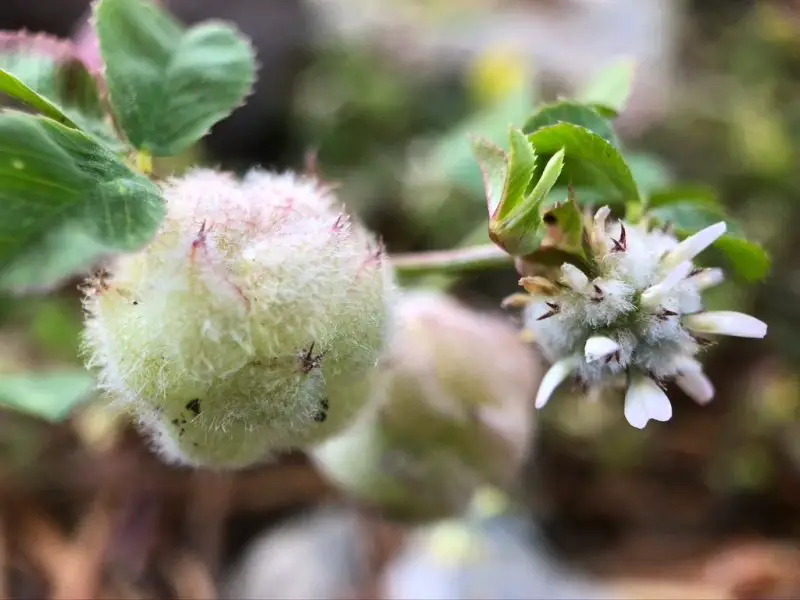
Woolly clover is a low-growing annual species named for its soft, hairy foliage and stems. The plant has a compact, spreading habit and small flower heads that range from pink to pale purple. These flowers are often surrounded by a woolly calyx, adding to the plant’s downy appearance.
Native to southern Europe and parts of western Asia, woolly clover grows in dry grasslands, roadsides, and open fields. It prefers full sunlight and sandy or rocky soils with good drainage. Blooming typically occurs in the spring and early summer, especially in regions with mild winters.
Woolly clover is valued in dryland pasture systems and ground cover mixes due to its drought tolerance and low-maintenance growth. Though it is not a major forage plant, it helps control erosion and supports insect biodiversity. Its charming, fuzzy texture also makes it suitable for informal wildflower gardens.
Whitetip Clover (Trifolium variegatum)

Whitetip clover is a variable annual species with distinctive flower heads that often feature white-tipped petals, giving the plant its name. The blooms can range in color from deep pink or purple to creamy white, usually appearing in loose, rounded clusters. It grows upright or sprawling and reaches about 6 to 12 inches in height.
This clover is native to western North America, particularly in California, Oregon, and Washington. It is found in diverse habitats such as meadows, open woodlands, coastal prairies, and even vernal pools. Whitetip clover adapts well to both moist and dry soils, and its bloom period extends from early spring into summer.
Ecologically, whitetip clover is an important nectar source for native bees and butterflies. It also contributes to soil health through nitrogen fixation and is sometimes used in habitat restoration projects. Due to its striking flowers and adaptability, it is occasionally planted in native plant gardens and wildflower mixes.
Meadow Clover (Trifolium medium)
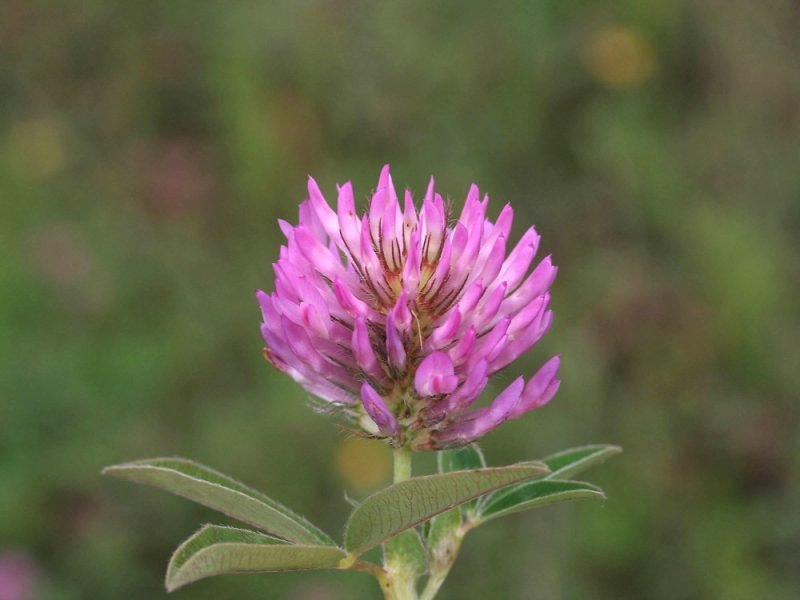
Meadow clover is a perennial species with rich magenta to purplish-red flower heads and a robust, leafy stem that can reach up to 2 feet in height. The plant has deep roots and a clumping growth habit, with leaves that are larger and broader than those of common clover species.
Native to Europe and parts of Asia, meadow clover thrives in moist meadows, forest clearings, and grassy hillsides. It prefers nutrient-rich, well-drained soils and performs best in full sun to light shade. Flowering typically occurs from late spring through early autumn, depending on local conditions.
Meadow clover is valued both ecologically and agriculturally. It is a useful forage plant for livestock due to its protein-rich foliage and high palatability. Additionally, it supports pollinators and soil health through nitrogen fixation, making it a beneficial species for sustainable farming and natural landscaping.
Cluster Clover (Trifolium glomeratum)
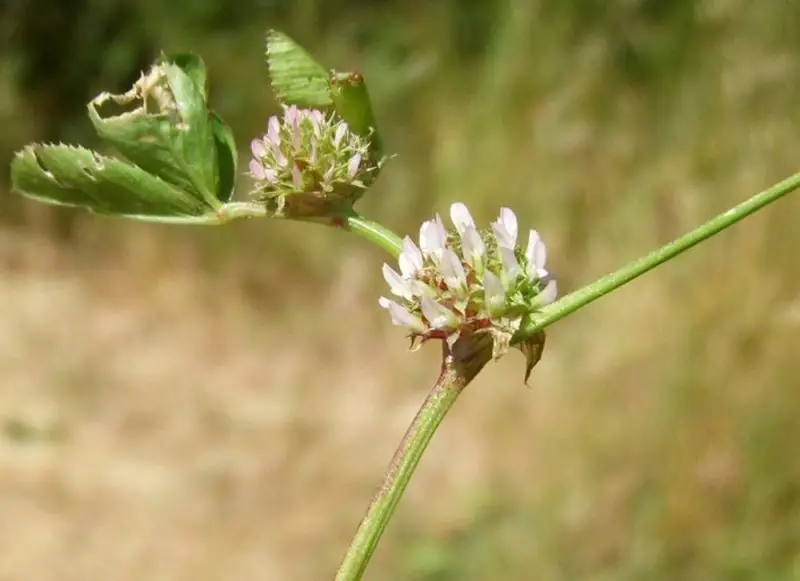
Cluster clover is a small annual species recognized for its tight, rounded clusters of pink to magenta flowers. The plant typically reaches a height of 4 to 8 inches and has narrow, trifoliate leaves. Its flower heads are dense and globular, giving it a compact and tidy appearance during bloom.
Native to Europe and introduced to North America, cluster clover commonly grows in dry, disturbed soils, roadsides, grasslands, and open pastures. It thrives in full sunlight and well-drained sandy or loamy soils. This species typically flowers from late spring to early summer and is tolerant of poor soil fertility.
While not widely used in agriculture, cluster clover plays a supportive ecological role by improving soil nitrogen and offering nectar to pollinators. Its ability to colonize disturbed sites makes it helpful in erosion control and land reclamation. Due to its attractive blooms, it may also appear in wildflower or pollinator garden seed mixes.
Long-stalk Clover (Trifolium longipes)
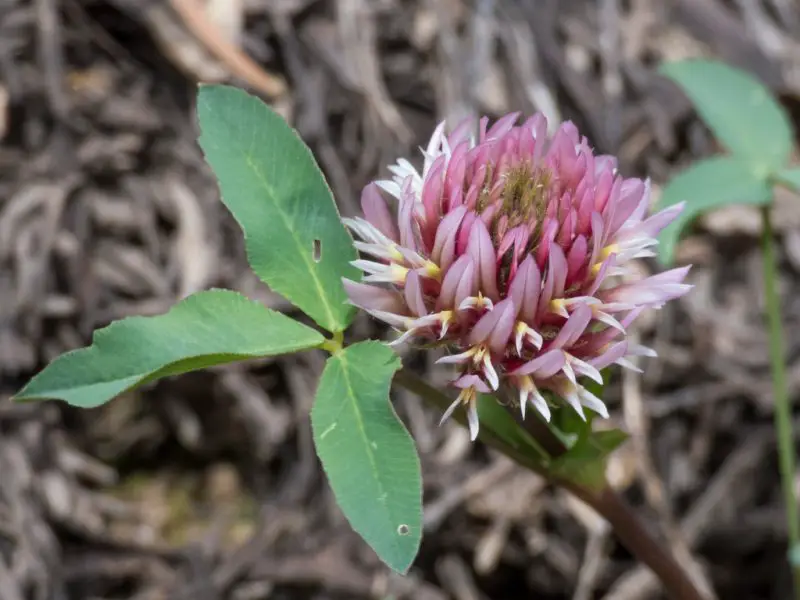
Long-stalk clover is a perennial species distinguished by its long flower stems and compact, pink to rose-colored flower heads. The flowers sit above a basal rosette of leaves on elongated stalks, giving the plant a graceful, upright appearance. The leaves are trifoliate with fine, hairy textures.
It is native to the western regions of North America, including mountainous areas of California, Oregon, and British Columbia. Long-stalk clover thrives in meadows, alpine slopes, and forest edges, particularly at higher elevations. It prefers moist, well-drained soils and blooms from late spring through summer.
This clover is important in native ecosystems for stabilizing soil and providing forage for wildlife. It also supports local pollinators like bees and butterflies. Although not commonly used in farming, its ecological value in natural landscapes and mountain meadows is significant, especially for restoration projects.
Pacific Clover (Trifolium wormskioldii)
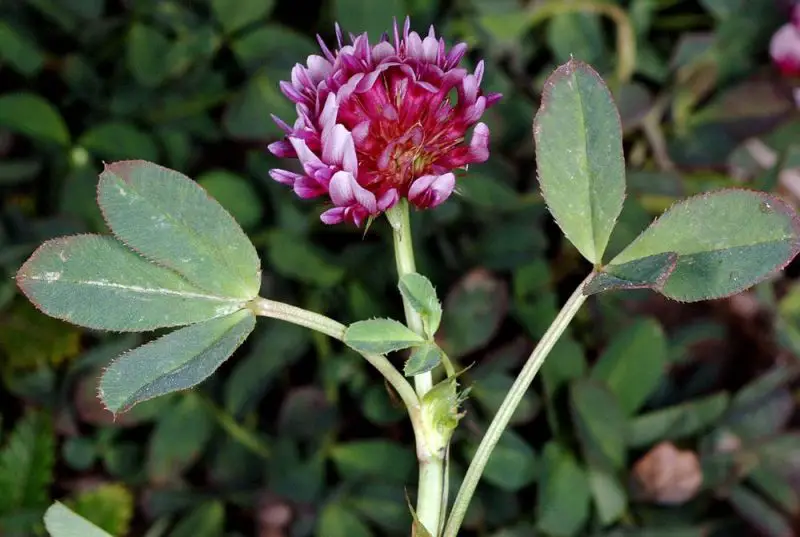
Pacific clover is a perennial species with vibrant reddish-purple flower heads and spreading, leafy stems that can reach up to 24 inches. Its flowers are dense and globular, sitting atop slender stalks. The foliage is lush, and the plant often forms colonies in wet or marshy ground.
This species is native to the Pacific Coast of North America, from Alaska to California. It grows in coastal wetlands, stream banks, moist meadows, and occasionally forest edges. Pacific clover thrives in saturated to seasonally wet soils and flowers during late spring to early summer.
Pacific clover serves important ecological functions in wetland environments. It provides forage for native herbivores and nectar for pollinators, especially bees. Additionally, it contributes to soil stabilization and nitrogen enrichment, making it beneficial for habitat restoration along waterways and wetland buffers.
Springbank Clover (Trifolium bejariense)
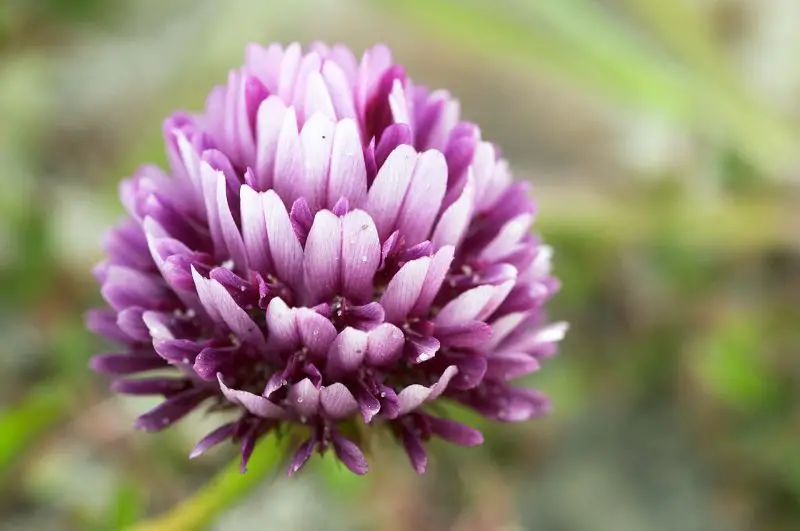
Springbank clover is a lesser-known species that produces rounded clusters of pink to pale purple flowers on erect stems. The plant typically reaches a height of 6 to 18 inches and has hairy stems and narrow trifoliate leaves. Its bloom gives off a subtle, delicate charm.
Native to the southern United States and parts of Mexico, this clover prefers moist, open woodlands, grasslands, and prairies. It grows well in sandy or loamy soils with good drainage and blooms in late spring to early summer. It’s adapted to warmer climates and is often found in regions with periodic rainfall.
While not widely cultivated, springbank clover supports native bees and butterflies by offering seasonal nectar. Its nitrogen-fixing abilities improve soil health, and it contributes to native prairie and grassland biodiversity. It may also be included in regional wildflower mixes for conservation purposes.
Buffalo Clover (Trifolium reflexum)

Buffalo clover is a rare and distinctive native clover species with pale pink to rose-colored flowers arranged in small, rounded heads. The flowers are slightly reflexed—curving downward—which gives the species its name. The plant has fine stems and spreads modestly in open patches.
It is native to the eastern and central United States, particularly in open oak woodlands, glades, and tallgrass prairies. Buffalo clover favors slightly acidic soils with moderate moisture and full to partial sun. It blooms in late spring to early summer, depending on the climate.
Buffalo clover is considered important for prairie restoration and native plant conservation. Once more widespread, its populations have declined due to habitat loss. Today, it is valued for its role in supporting native pollinators and contributing to the floral diversity of restored or protected grasslands.
Running Buffalo Clover (Trifolium stoloniferum)
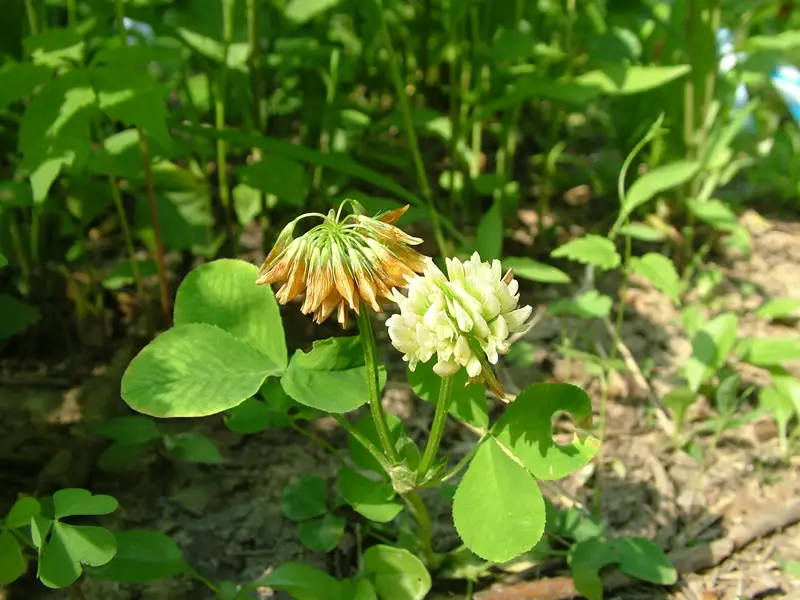
Running buffalo clover is a rare, stoloniferous perennial with white flowers and distinct runners that spread across the ground. The flower heads are relatively small, with 1 to 2 flowers per stem, and its trifoliate leaves are smooth and rounded. The plant grows low to the ground and often blends into grassy surroundings.
This species is native to the eastern and midwestern United States and typically found in lightly shaded woodlands, streambanks, and old pastures. It prefers moist, well-drained soils with moderate fertility and minimal competition from aggressive grasses. Blooming occurs from late spring to early summer.
Once thought extinct, running buffalo clover has been rediscovered in several states and is now listed as federally endangered. It has ecological importance in forest restoration and is used in conservation projects to revive native understory communities. Its dependence on periodic disturbance for growth reflects the historical role of grazing bison in its habitat.
Foothill Clover (Trifolium ciliolatum)
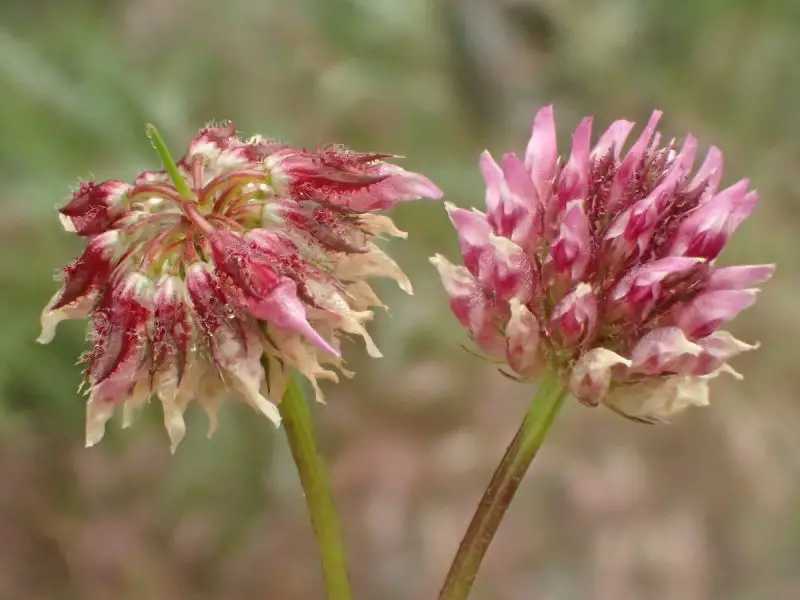
Foothill clover is an annual wildflower with rose to purplish-pink flowers and hairy, toothed leaves. The flower heads are globular and sit atop short stems, while the plant itself grows low and spreads modestly. The foliage is slightly fuzzy, and the plant’s compact size makes it suitable for dry landscapes.
Native to the western United States, especially California, foothill clover thrives in grasslands, open woodlands, and dry slopes at low to moderate elevations. It prefers sandy or rocky soils and blooms from mid-spring through early summer. It is well-adapted to Mediterranean climates with wet winters and dry summers.
Foothill clover is useful in wildflower meadows and native habitat gardens, providing food for bees and small mammals. It plays a role in nitrogen fixation and soil stabilization in fragile or degraded sites. Its drought tolerance and low growth habit also make it an asset in erosion control and habitat restoration in arid environments.
Tomcat Clover (Trifolium willdenovii)
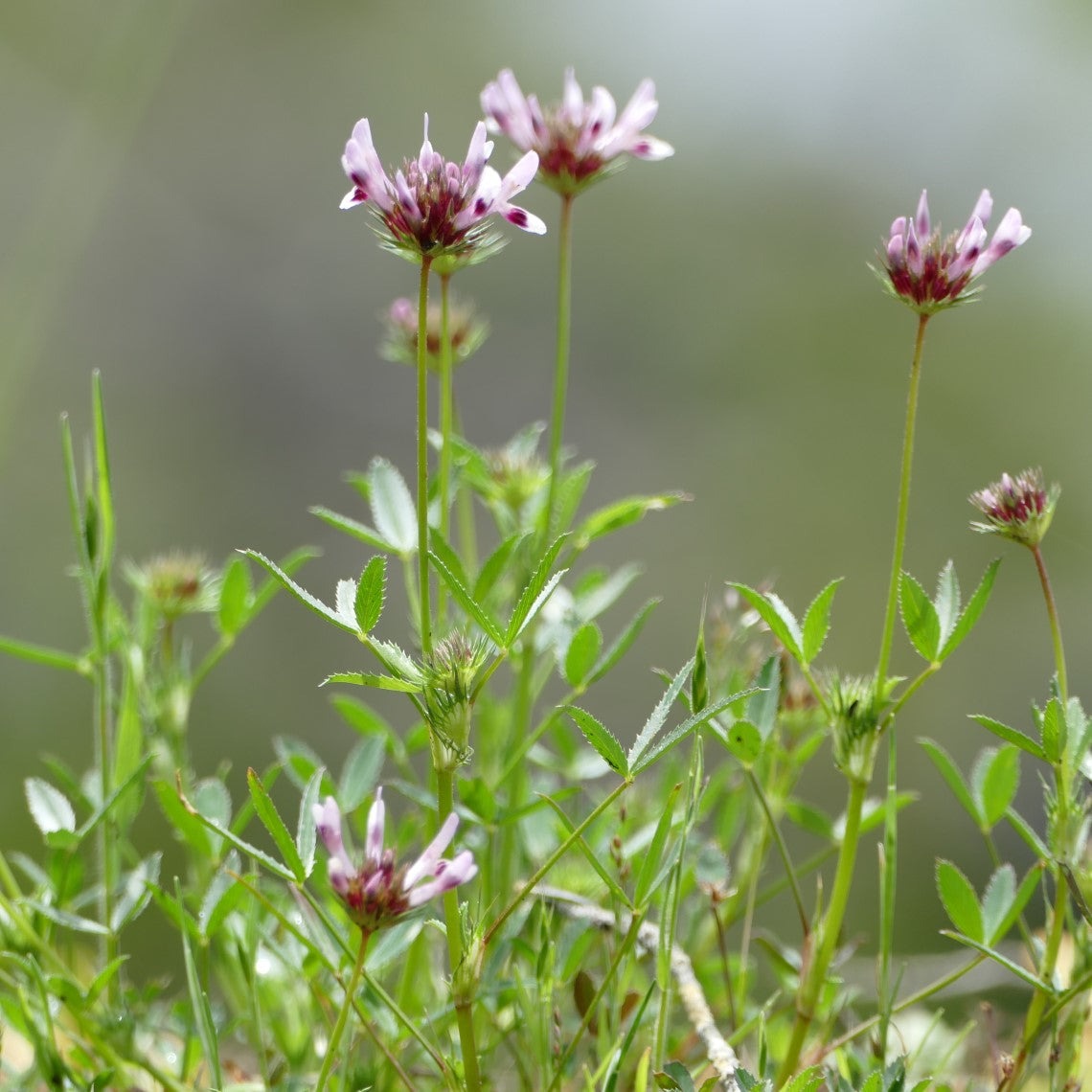
Tomcat clover is an attractive annual with showy purple to bluish-purple flowers and soft, hairy leaves. The flowers form tight, ball-shaped heads, often with darker markings, and the plant usually reaches 6 to 12 inches in height. It is named for its sharp scent, which some describe as similar to a tomcat.
This species is native to the western United States, particularly in California and Oregon, and grows in coastal prairies, woodlands, and open meadows. It prefers loamy or sandy soils and blooms in the spring, usually from March to May. It thrives in both sun and light shade in areas with mild, wet winters.
Tomcat clover is valued for its ornamental appeal and usefulness in pollinator gardens. It supports native bees and butterflies and adds colorful diversity to wildflower plantings. Its ability to thrive in open, undisturbed areas makes it a candidate for native plant restoration and eco-friendly landscaping.
Dwarf Clover (Trifolium nanum)
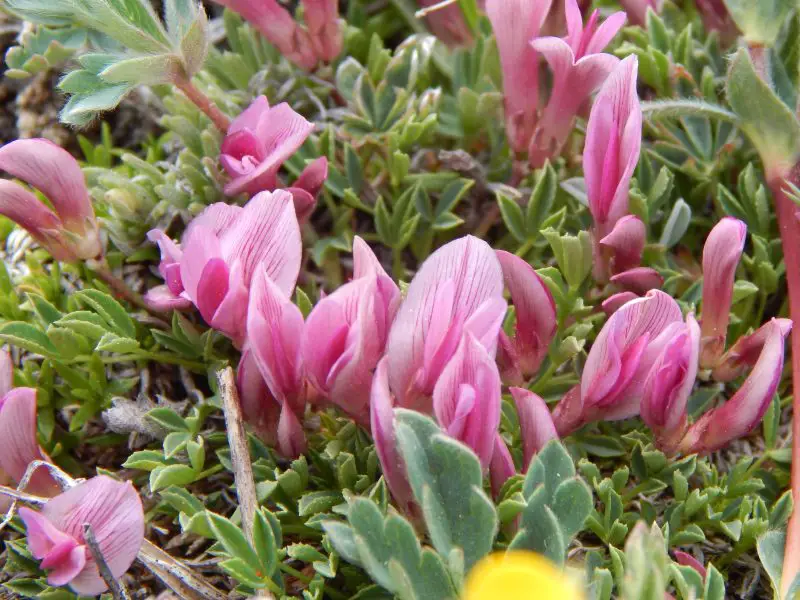
Dwarf clover is a tiny perennial species with small, pale pink to lavender flower heads and minute trifoliate leaves. The plant typically grows just a few inches tall and hugs the ground, forming mats across rocky terrain. Its size and resilience make it especially notable among alpine clovers.
This clover is native to high-elevation regions of the Rocky Mountains, from Colorado to New Mexico. It is often found in subalpine and alpine meadows, scree fields, and gravelly soils above the tree line. Dwarf clover blooms during the short summer growing season from June to August.
Due to its hardiness, dwarf clover plays an important ecological role in mountain ecosystems. It helps prevent erosion and stabilizes fragile alpine soils. While it has no major agricultural use, its ecological niche and extreme adaptability make it valuable for conservation and study in high-altitude plant communities.
Bent Trifolium (Trifolium amabile)
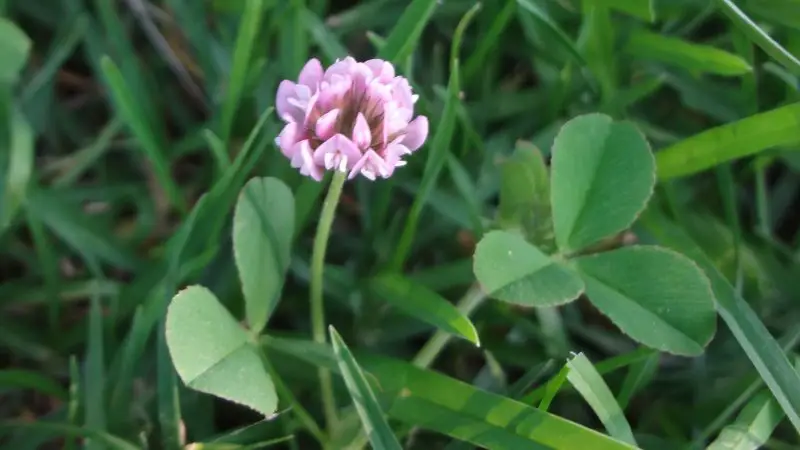
Bent trifolium, also known as “charming clover,” is a graceful species with small purple to violet flowers arranged in loose heads. Its stems tend to arch or bend, giving the plant a soft, flowing appearance. The leaves are finely textured and often have a delicate, airy quality.
This species is native to Central and South America, particularly in countries like Mexico, Peru, and Ecuador. It grows in a variety of environments, from dry hillsides to open woodlands, often in areas with moderate elevation and well-drained soils. Flowering typically occurs during spring and early summer, depending on the local climate.
Though not widely cultivated, bent trifolium is occasionally used in native landscaping and erosion control due to its low-growing, spreading habit. It provides forage for local insects and helps improve soil nitrogen levels in the areas where it grows. Its ornamental charm and adaptability make it an interesting choice for native plant enthusiasts.
Cow Clover (Trifolium wormskioldii)
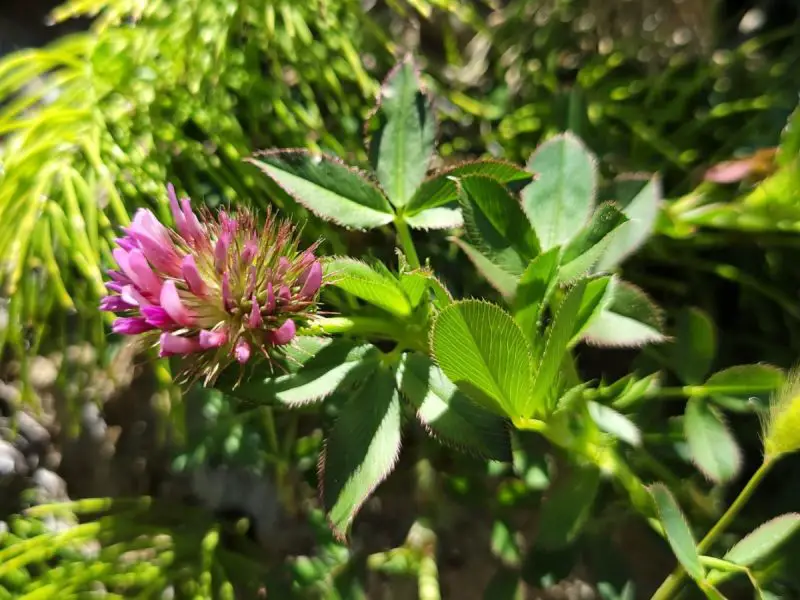
Cow clover is a perennial species with rose to magenta flower heads that are relatively large and showy. The plant grows up to 24 inches tall, featuring long, hairy stems and broad, trifoliate leaves. The blossoms are loosely clustered, often appearing in moist, open areas.
This clover is native to the western United States, particularly along the Pacific Coast, including California, Oregon, and Washington. It is typically found in wet meadows, streambanks, and coastal prairies. Cow clover blooms from late spring to early summer, depending on moisture levels and elevation.
Cow clover is highly valuable to native pollinators, especially bumblebees and butterflies. It also plays a role in stabilizing soil along riparian zones and serves as a nitrogen fixer in degraded habitats. Its adaptability to both saline and freshwater environments makes it especially useful in ecological restoration projects.
Seaside Clover (Trifolium polyodon)
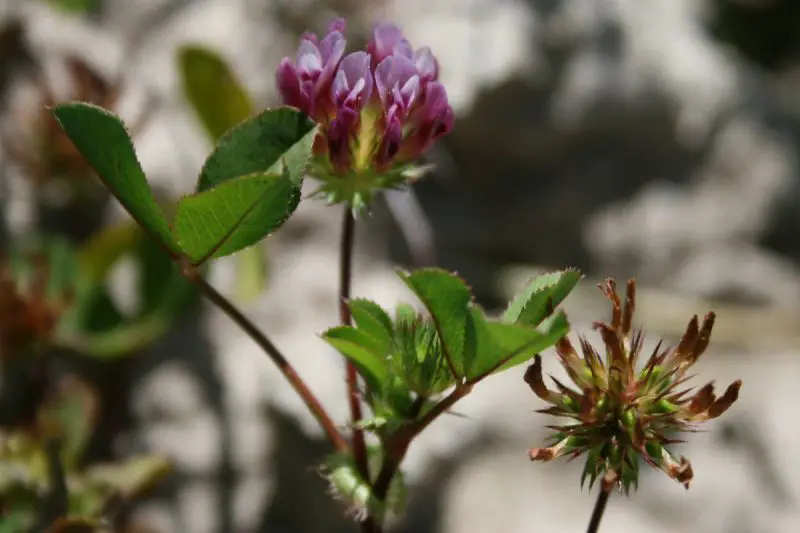
Seaside clover is a low-growing, spreading perennial with delicate pink to rose-colored flower heads. The stems are creeping and often root at the nodes, forming dense mats. Its trifoliate leaves are rounded and slightly succulent, helping it retain moisture in salty coastal conditions.
This species is native to coastal areas of California and parts of Baja California, thriving in salt marshes, coastal dunes, and moist grassy flats. It prefers sandy, saline, or loamy soils and typically blooms from spring through early summer. It is highly tolerant of wind, salt spray, and periodic flooding.
Seaside clover plays an essential role in coastal stabilization and erosion control. It also serves as a nectar source for pollinators and helps improve soil structure in areas prone to salinity. While not commonly used in agriculture, it has applications in native landscaping and ecological restoration along the coast.
Oregon Clover (Trifolium owyheense)
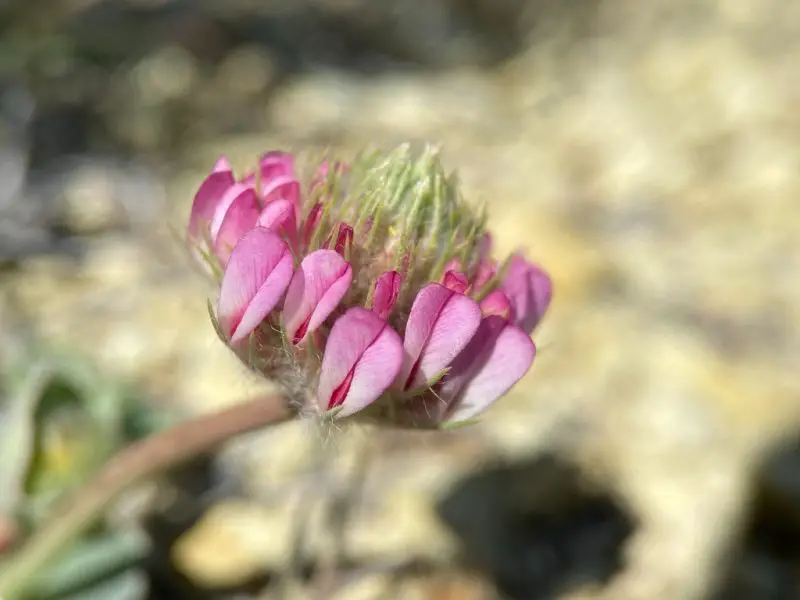
Oregon clover is a rare and modest perennial with small, pale purple to lavender flowers and finely textured leaves. The flower heads are compact and round, supported by thin stems that rise just a few inches above the ground. It has a dainty appearance but is well adapted to harsh, dry environments.
This clover is endemic to Oregon and nearby areas of the Intermountain West. It is found in sagebrush scrub, dry mountain meadows, and basalt outcrops at mid to high elevations. Oregon clover blooms during late spring and early summer, particularly in years with adequate rainfall.
Though it has limited commercial use, Oregon clover is ecologically important as a native forage plant for insects and small mammals. It also contributes to nitrogen cycling in arid and semi-arid ecosystems. Conservation of this clover helps preserve regional biodiversity and supports pollinator health in its native range.
Sand Clover (Trifolium dasyphyllum)
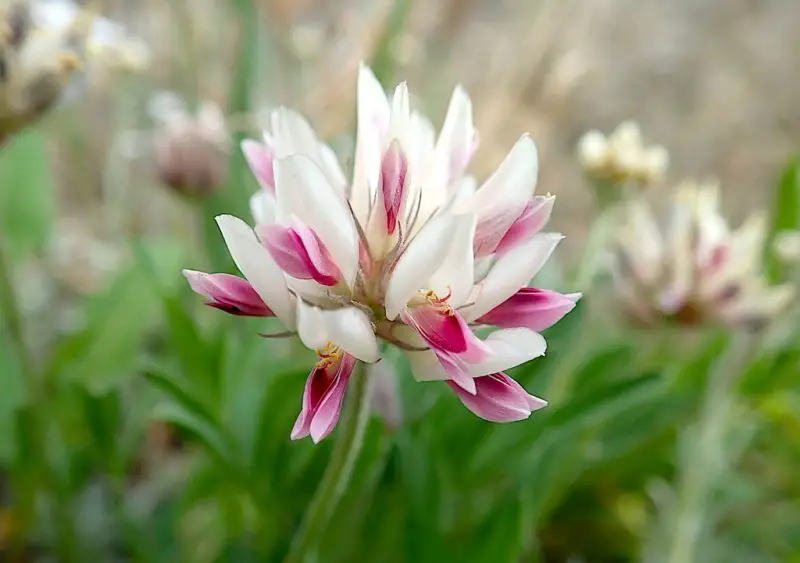
Sand clover is a compact, mat-forming perennial with soft, hairy leaves and small, pink to light-purple flower clusters. Its name reflects the thick, woolly covering on its leaves, which helps retain moisture and reflect sunlight in arid habitats. The plant typically remains under 6 inches in height.
This clover is native to the Rocky Mountains and Intermountain West, particularly in Colorado, Utah, and Wyoming. It prefers sandy or gravelly soils, often in open slopes, meadows, or alpine ridges. Sand clover flowers in late spring and early summer, just after snowmelt in its native habitat.
Sand clover is important for erosion control and soil stabilization in dry alpine regions. It supports native bees and plays a modest role in forage systems where other plants may struggle to grow. Its high drought tolerance and nitrogen-fixing capabilities make it valuable for restoration projects in fragile upland environments.
Smallflower Clover (Trifolium microcephalum)
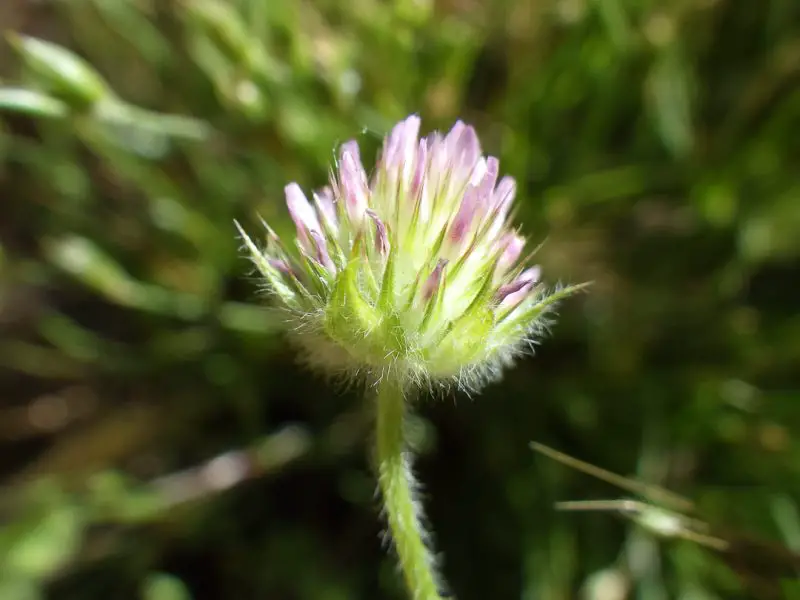
Smallflower clover is a delicate, annual or biennial species with tiny, pale pink to creamy-white flowers that form small, ball-shaped heads. The plant is low-growing and slender, often blending into surrounding grasses. Its trifoliate leaves are narrow and finely serrated.
This species is native to western North America, including California, Oregon, and British Columbia. It is typically found in open woodlands, grassy hillsides, and coastal bluffs. Smallflower clover blooms from early to mid-spring, taking advantage of seasonal rains and cooler temperatures.
While not cultivated on a large scale, smallflower clover contributes to pollinator support and adds botanical diversity to native habitats. Its early bloom time makes it an important food source for emerging bees. It also helps enrich the soil with nitrogen and supports ecological balance in lightly disturbed areas.






